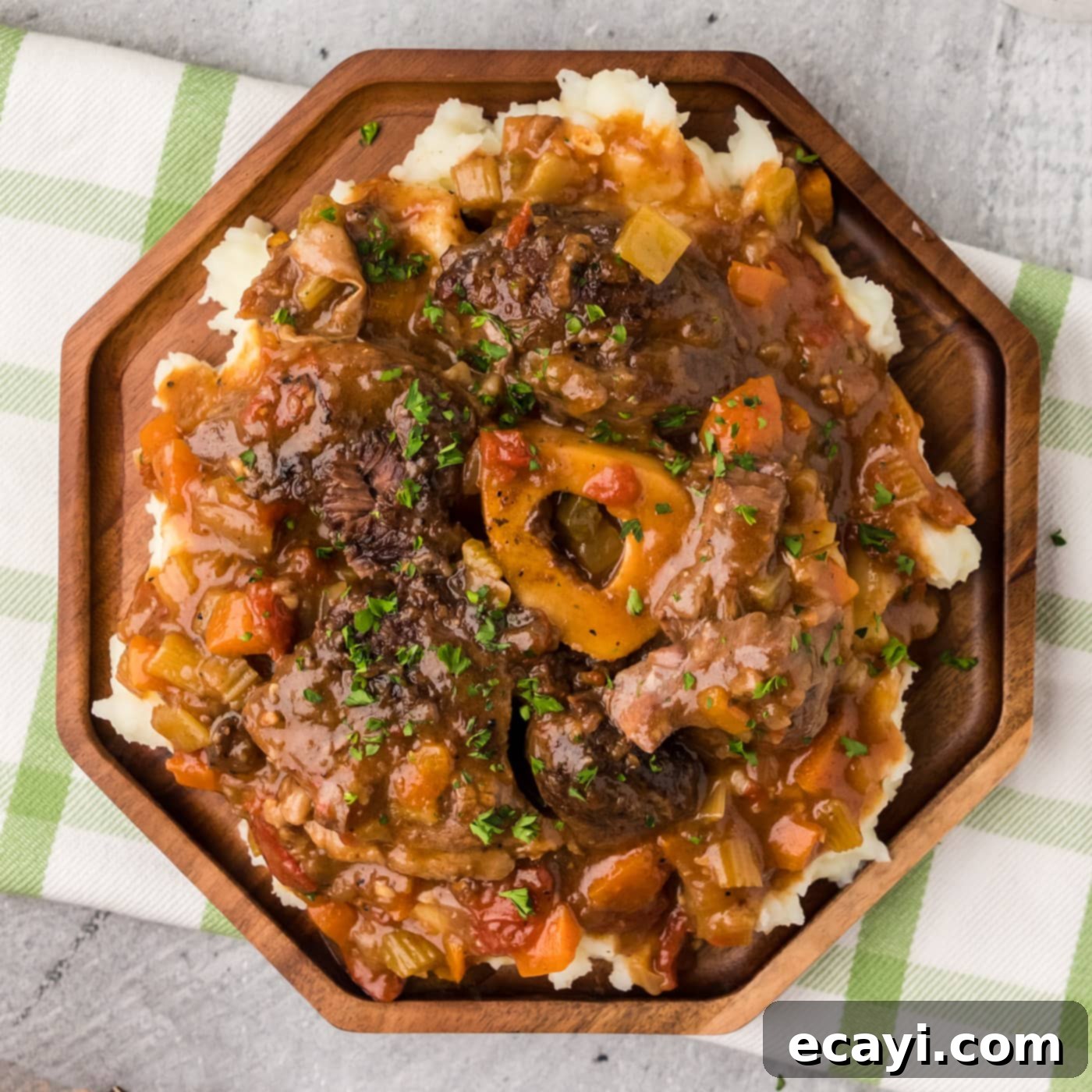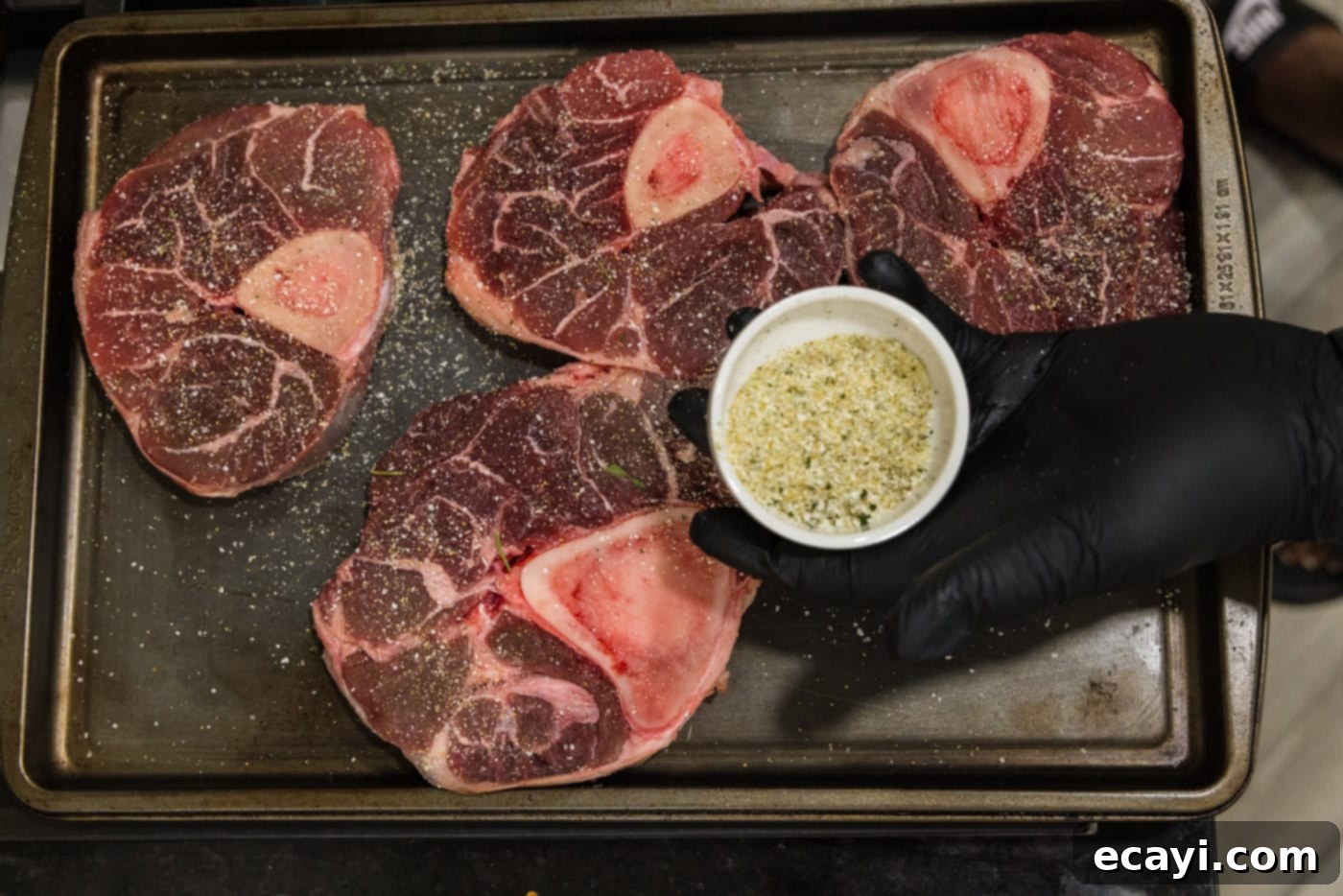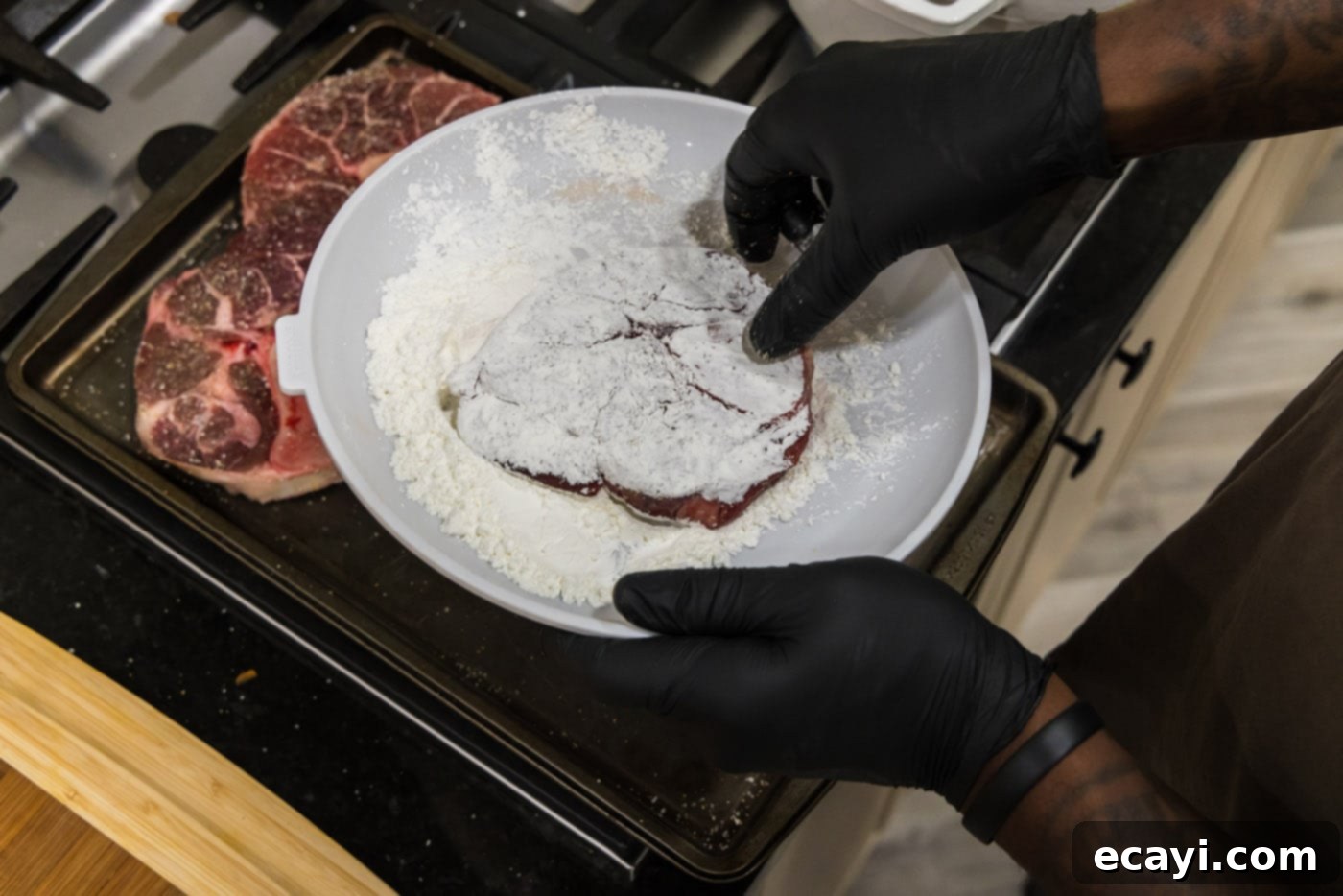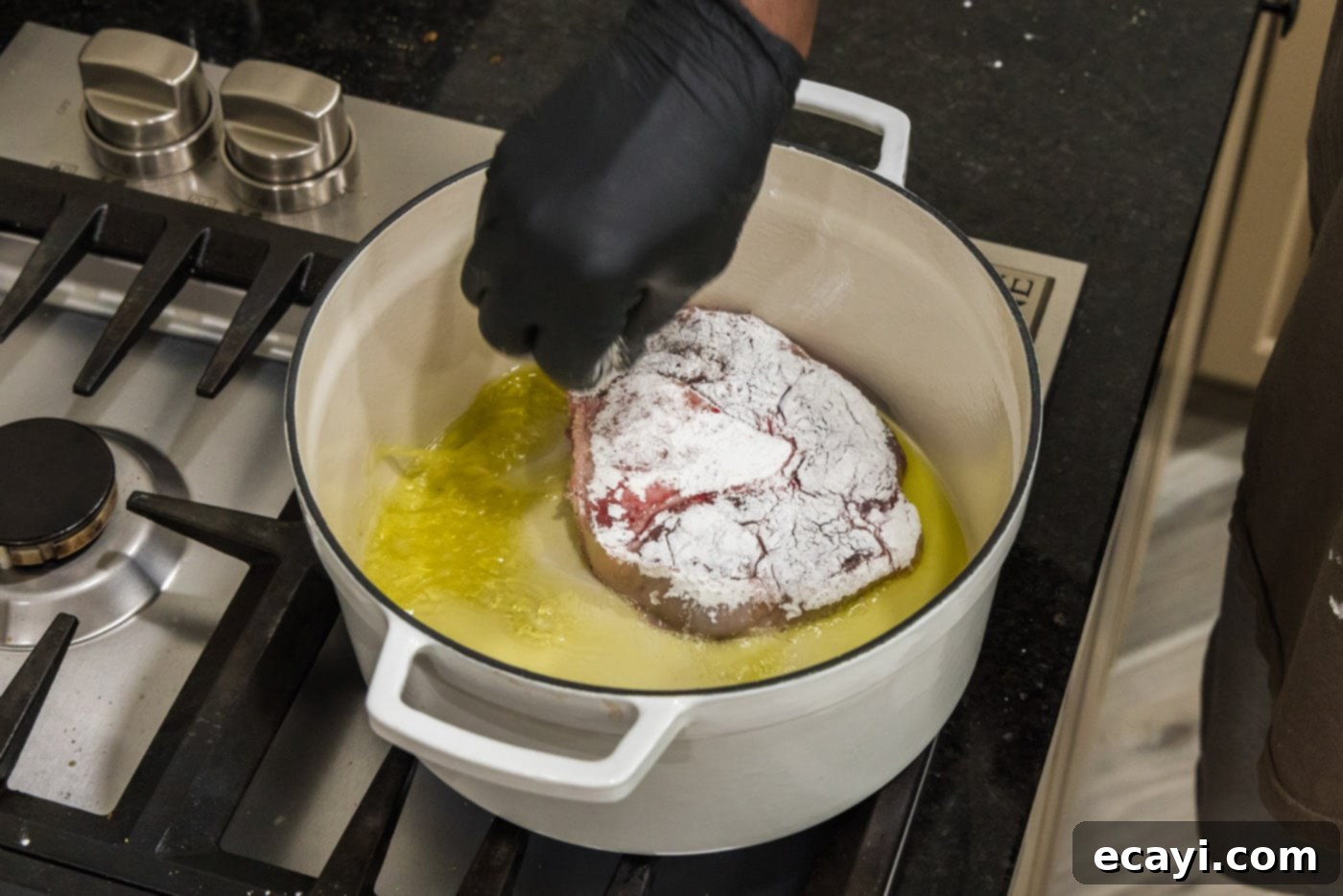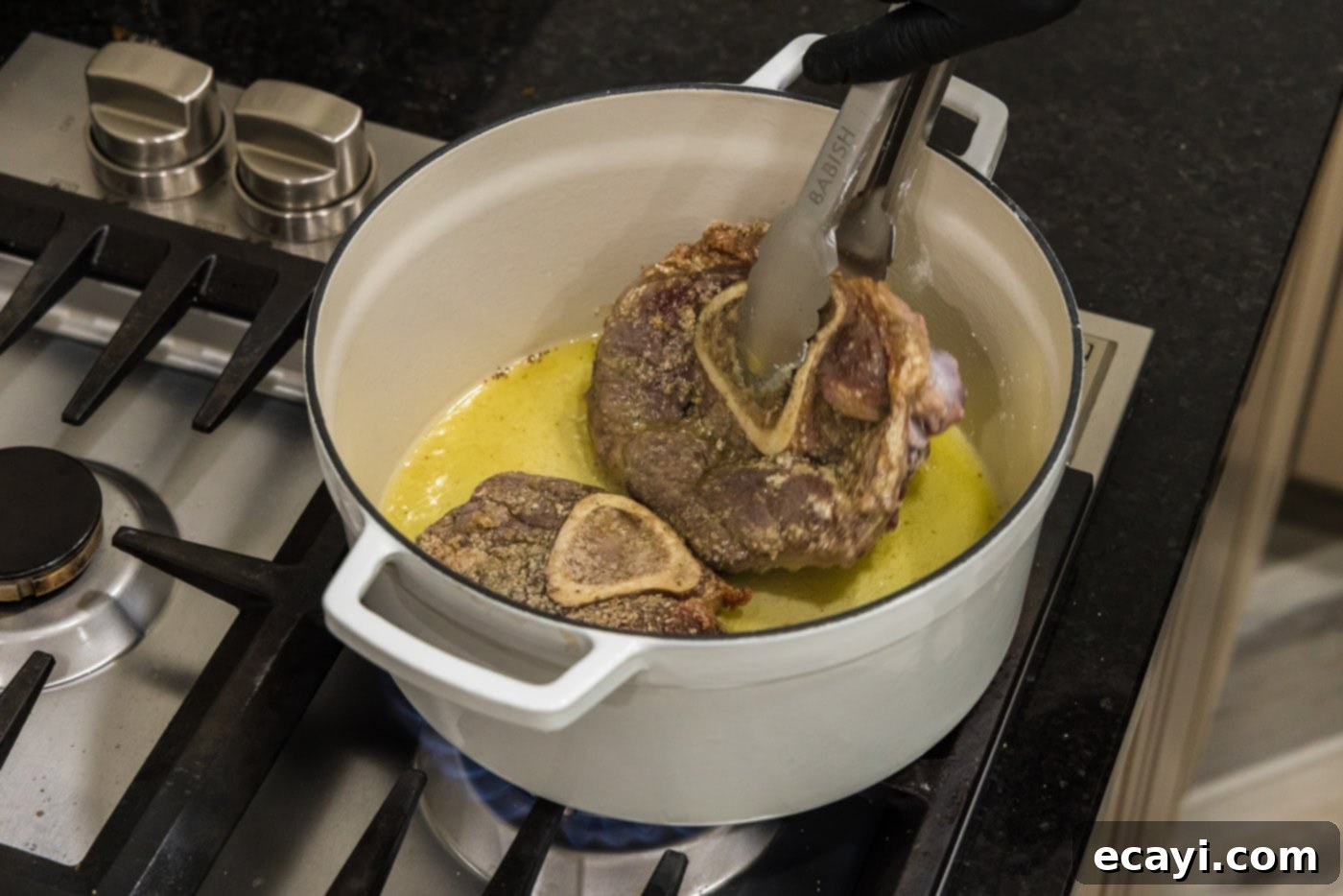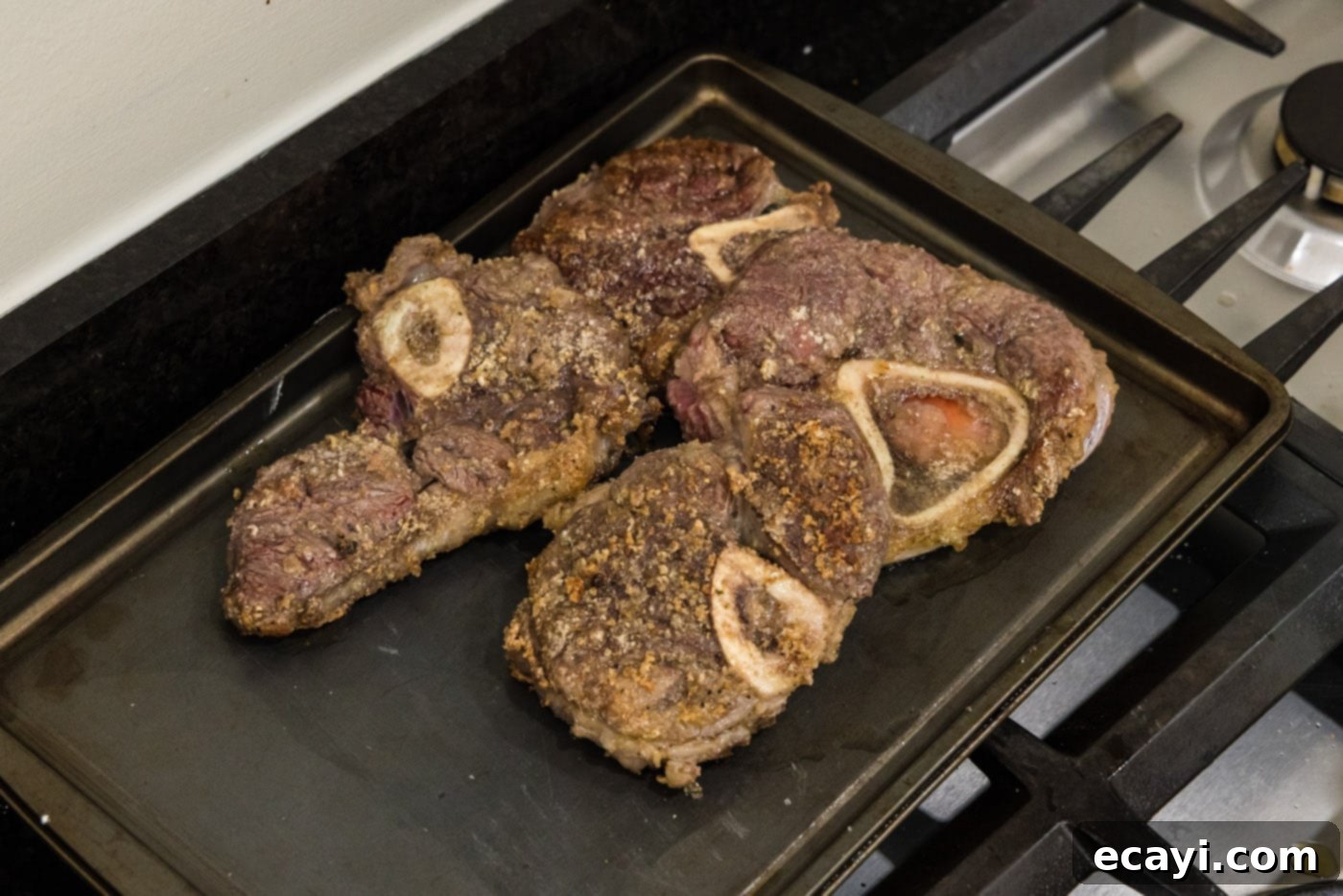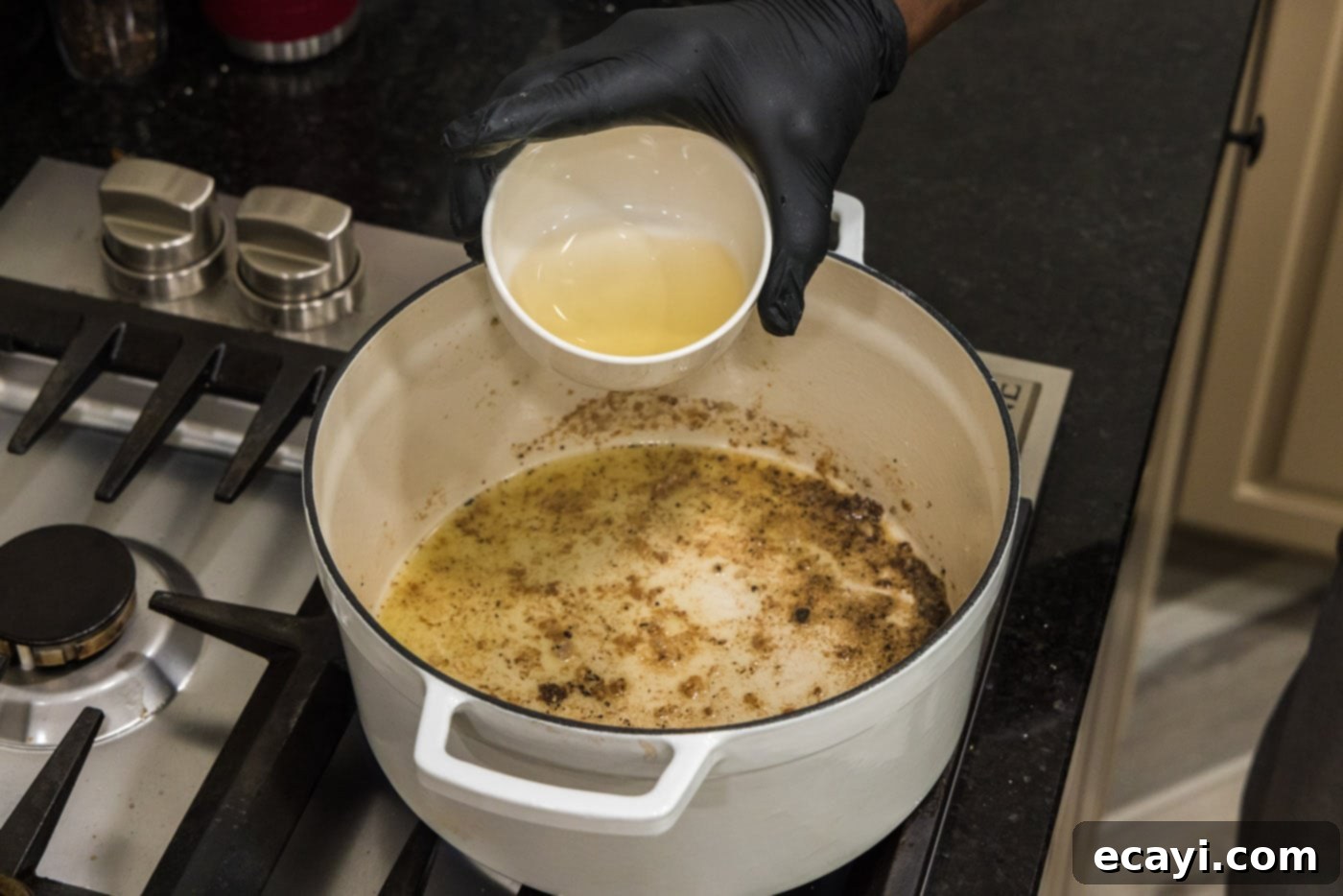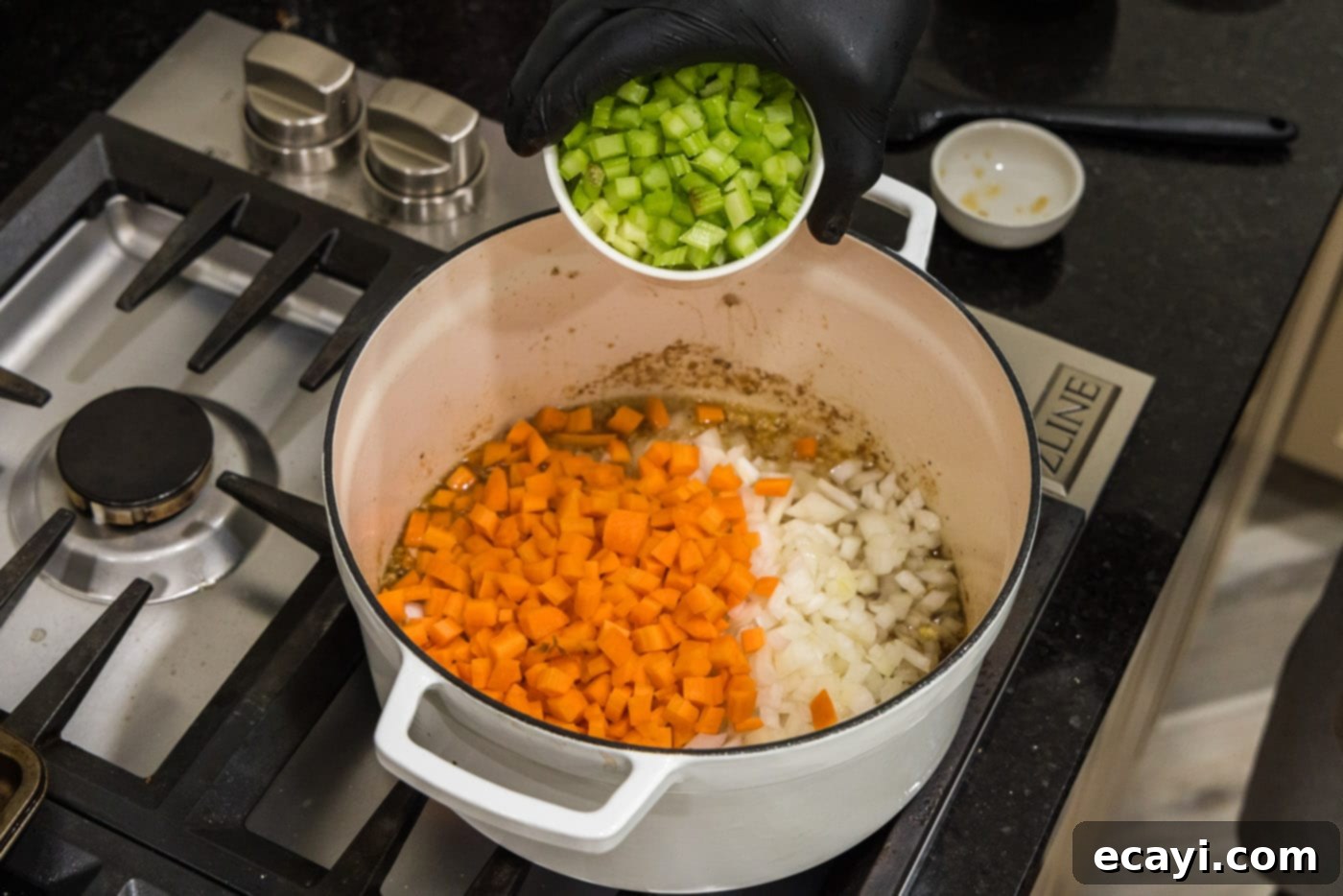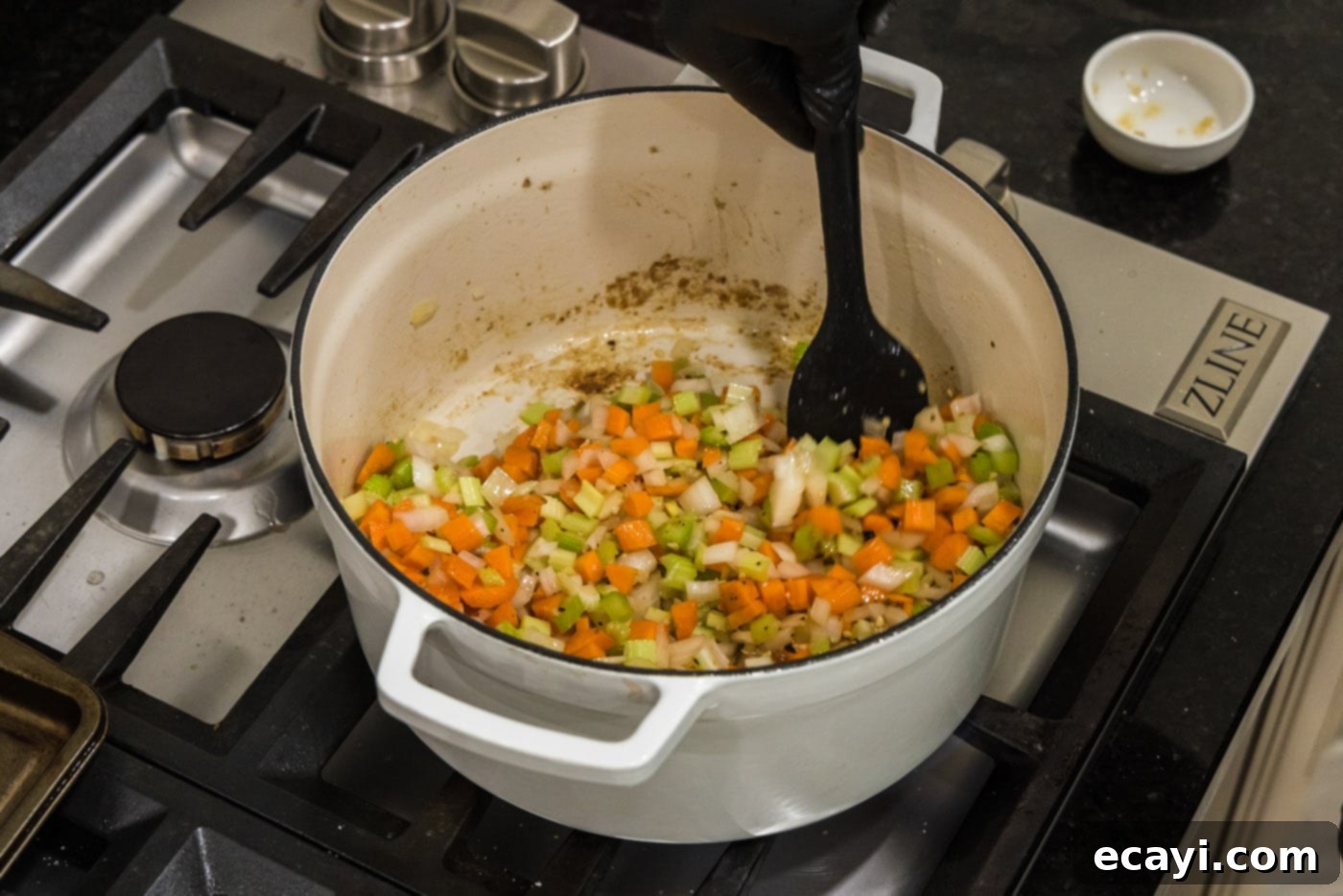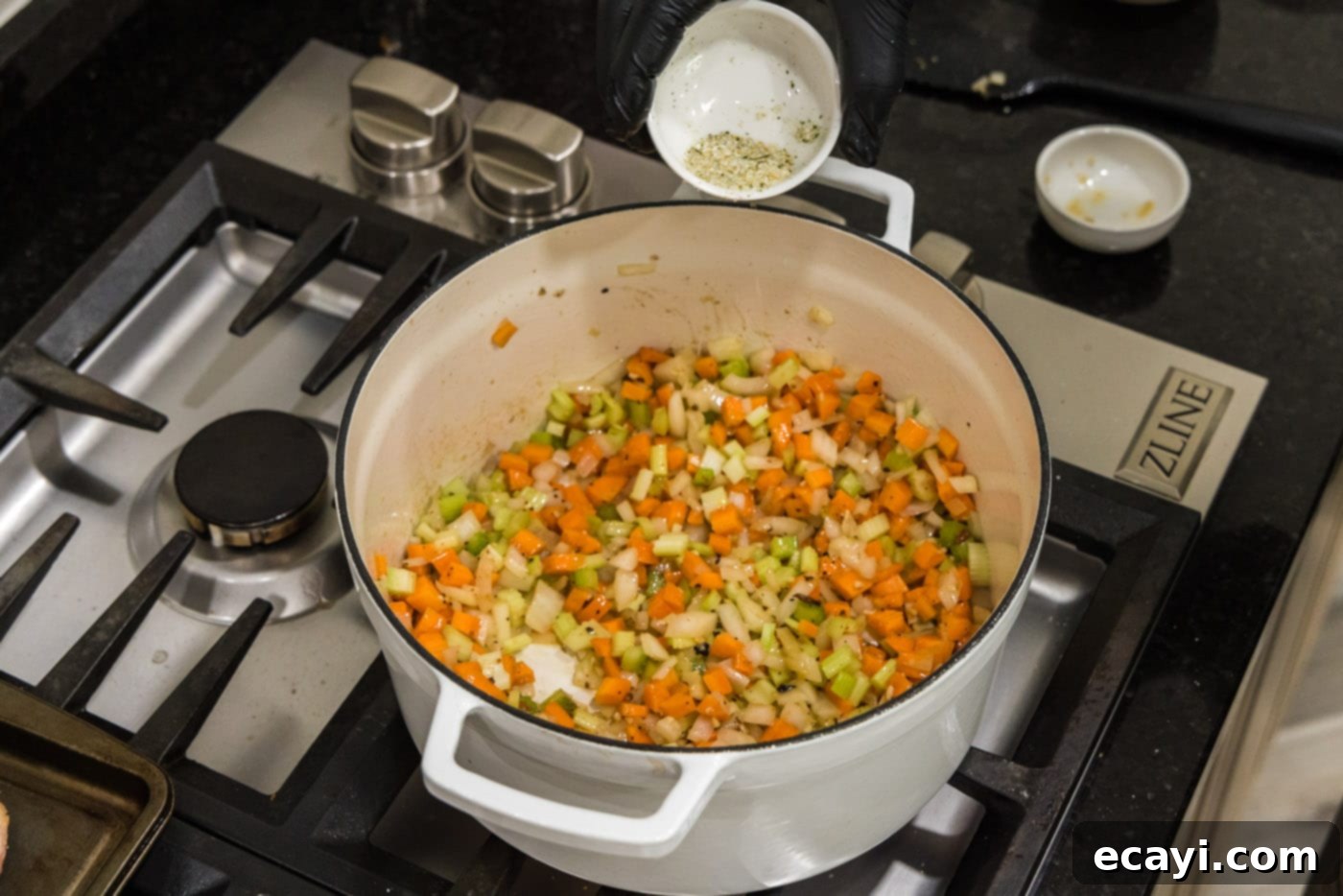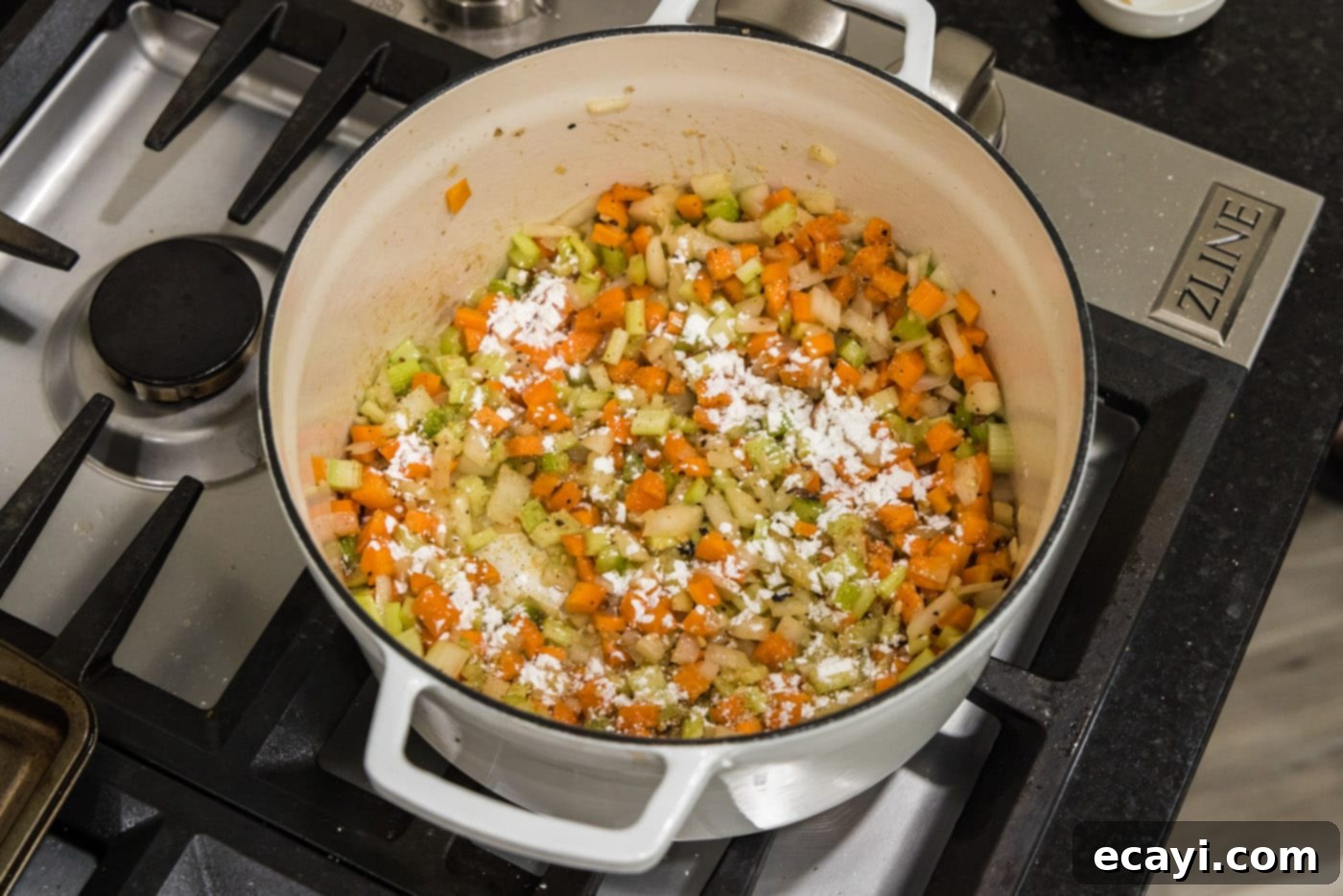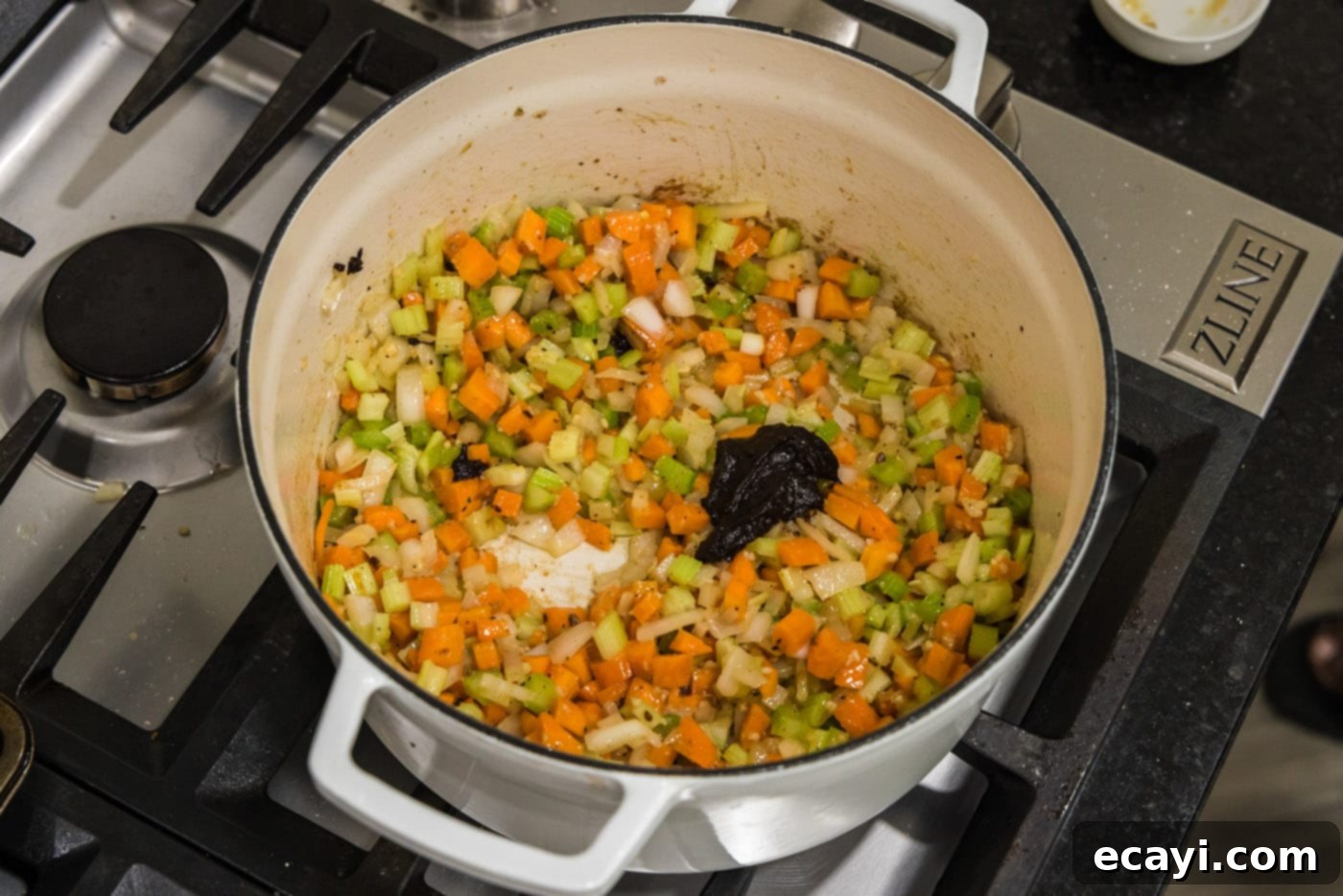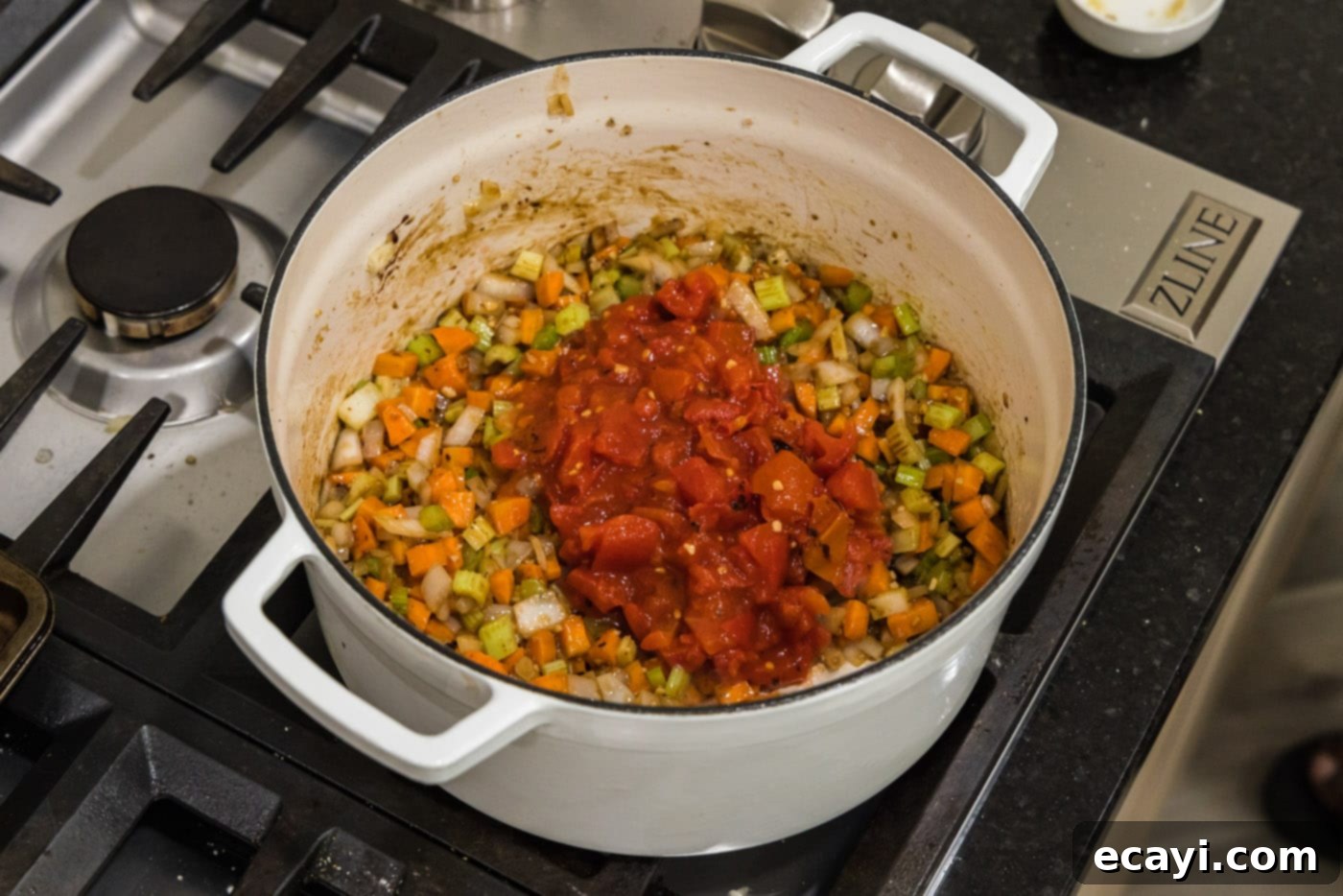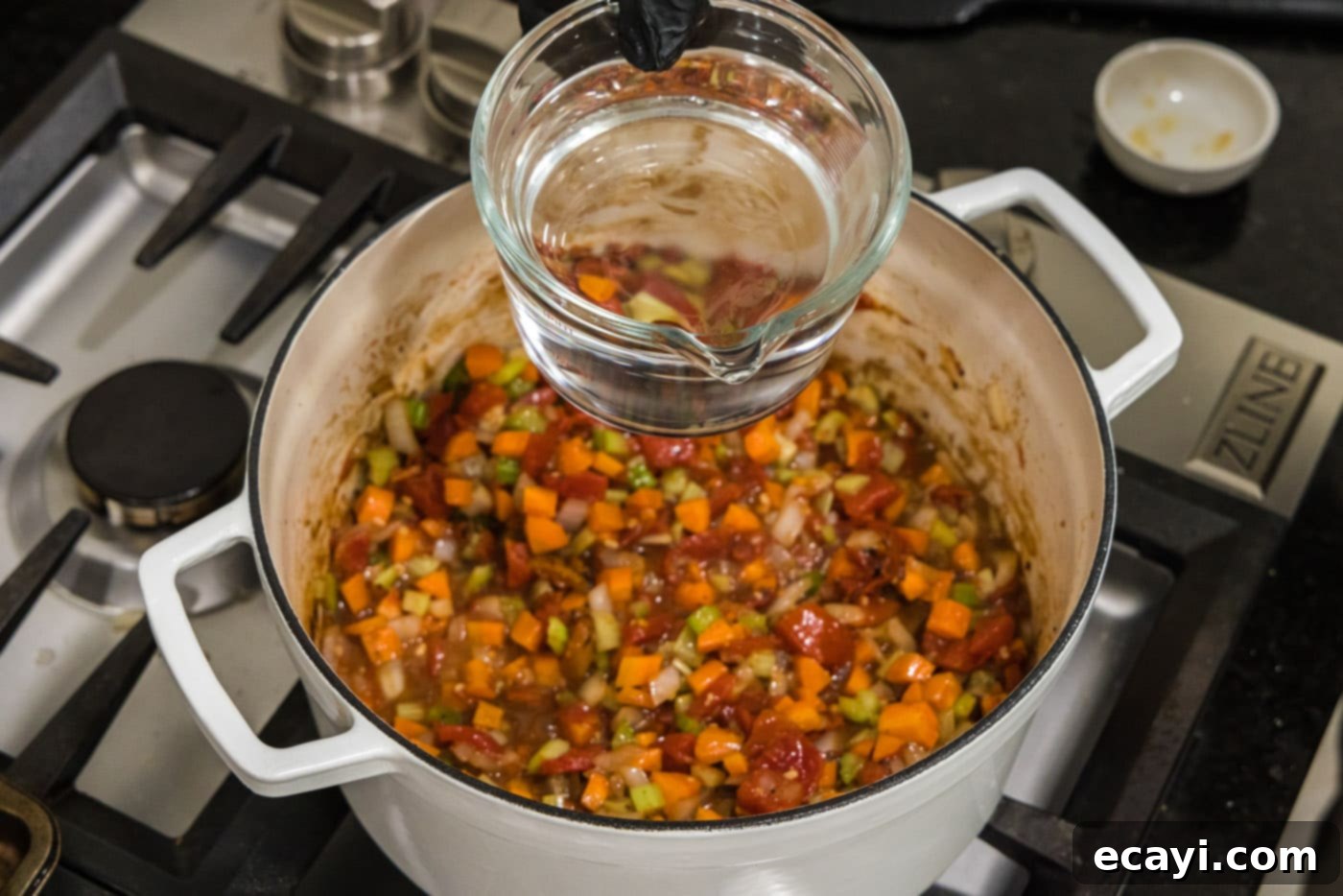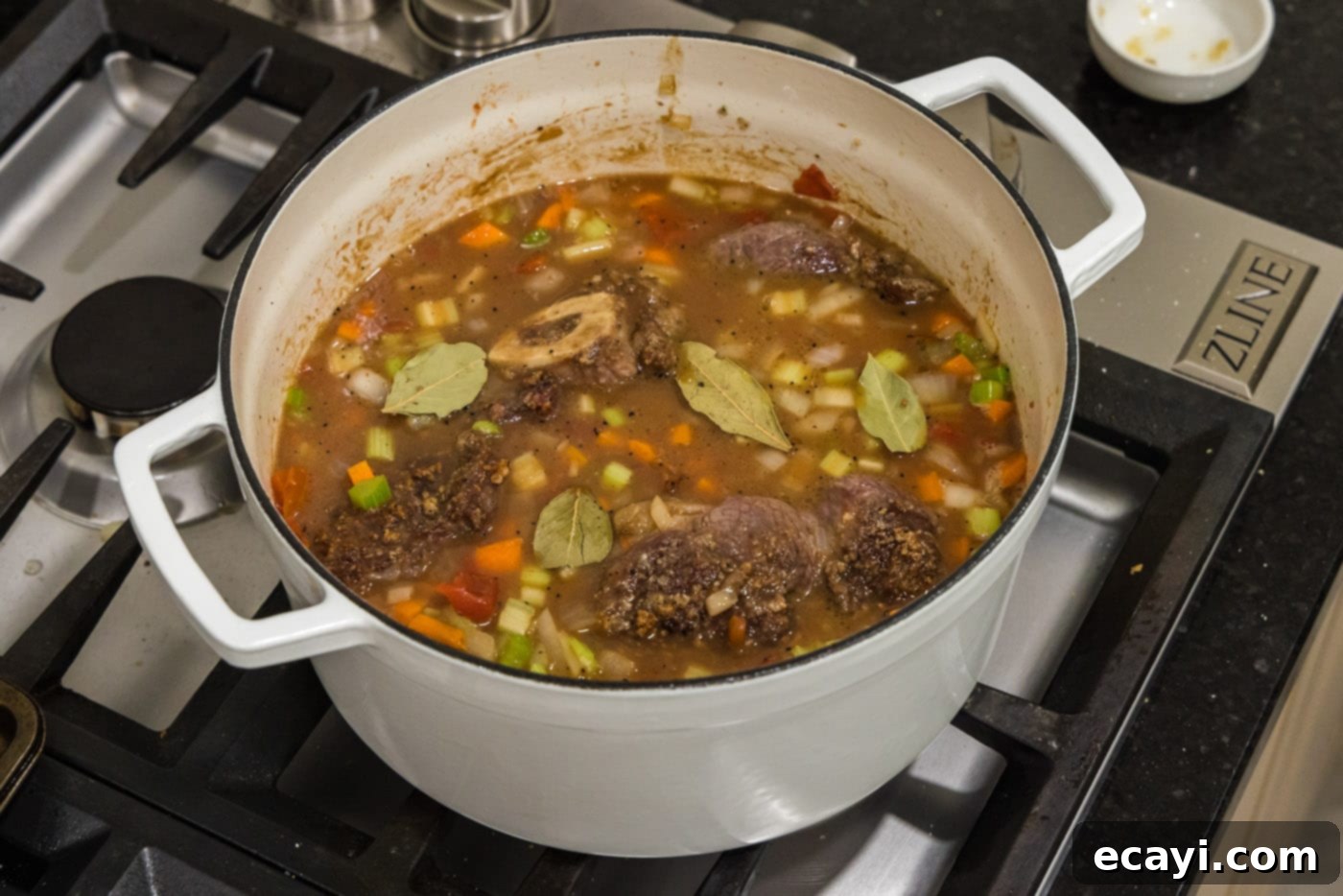The Ultimate Braised Beef Shanks Recipe: Fall-Off-The-Bone Tenderness in a Rich White Wine Sauce
Prepare to be enchanted by the rich, comforting flavors of this classic braised beef shanks recipe. This dish transforms a humble cut of meat into an extraordinary culinary experience, featuring succulent, fall-off-the-bone beef shanks bathed in a deeply aromatic sauce. A harmonious blend of garlic, onion, celery, carrots, and ripe tomatoes forms the foundation of a luxurious white wine base, creating a meal that’s both hearty and elegantly satisfying. Perfect for a cozy family dinner or an impressive gathering, these braised beef shanks promise to deliver an unforgettable taste and texture.
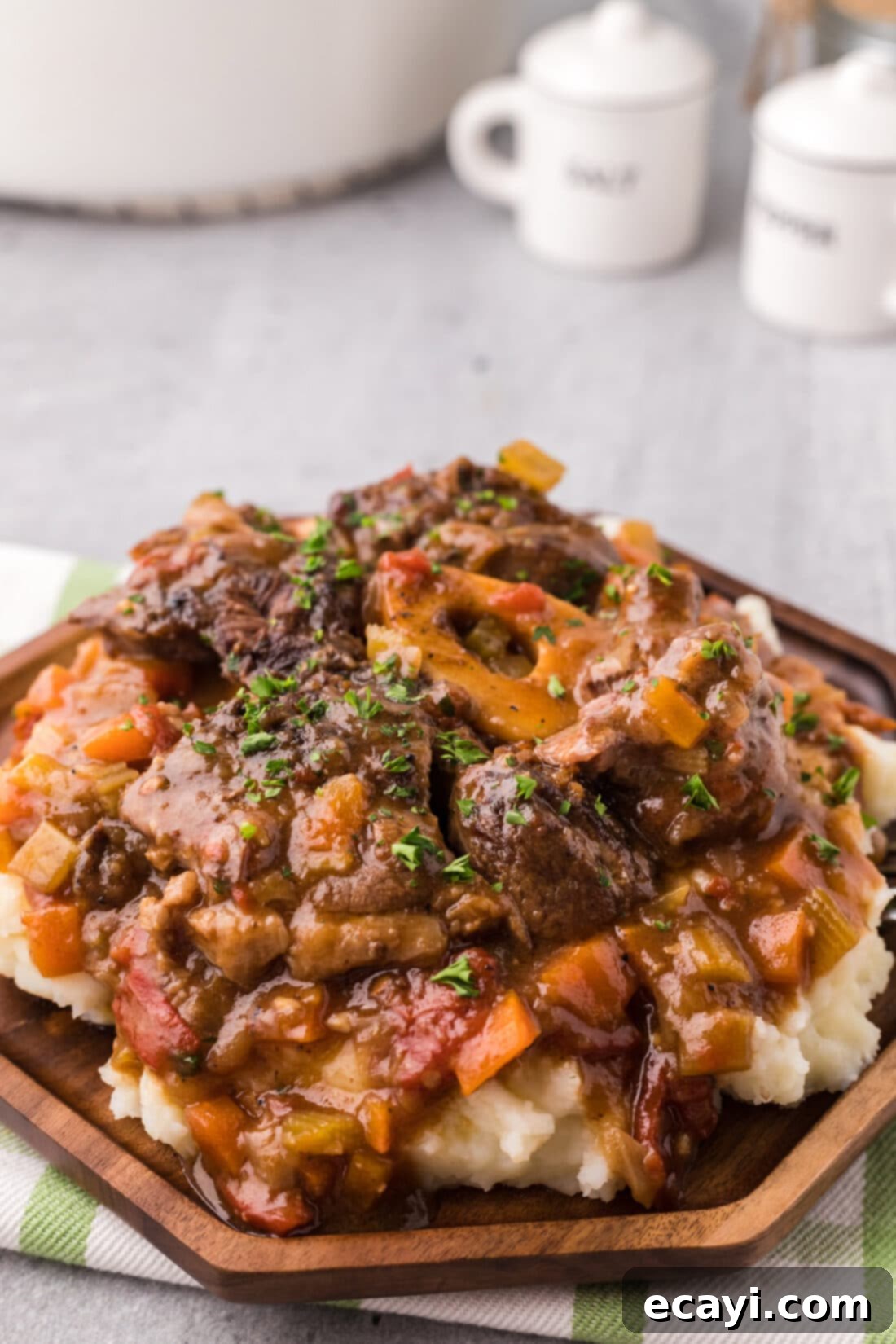
The Magic Behind This Braised Beef Shanks Recipe
This braised beef shanks recipe is a testament to the power of low and slow cooking. Beef shanks, often considered a tough cut, are transformed through this method into an unbelievably tender, melt-in-your-mouth delight. The process begins with a crucial step: searing the beef shanks to develop a rich, caramelized crust, locking in flavor and creating a beautiful depth. This initial browning, known as the Maillard reaction, is vital for the overall taste of the finished dish.
After searing, we deglaze the pan with dry white wine, releasing all those flavorful browned bits stuck to the bottom, which then infuse into our braising liquid. Following this, a classic mirepoix (onions, carrots, celery) is sautéed, building layers of aromatic flavor. Finally, the seared shanks are returned to the pot, submerged in the rich braising liquid with tomatoes and bay leaves, and then slowly cooked in the oven for several hours. This extended cooking time at a low temperature breaks down the tough connective tissues in the beef, converting them into gelatin. This gelatin is what gives braised meat its characteristic succulent texture and contributes significantly to the richness and body of the sauce.
The bone in beef shanks plays a crucial role too. It not only adds to the visual appeal but also imparts a deep, savory flavor to the braising liquid, especially from the marrow within. The result is a dish where the meat effortlessly falls away from the bone, swimming in a thick, luxurious sauce that begs to be savored.
Many recognize this dish as the beef counterpart to Osso Buco, the renowned Italian veal dish. While both are incredibly rich, hearty, and feature cross-cut shanks, beef shanks offer a more robust flavor profile and are generally more accessible and budget-friendly than veal, making them a popular choice for home cooks.
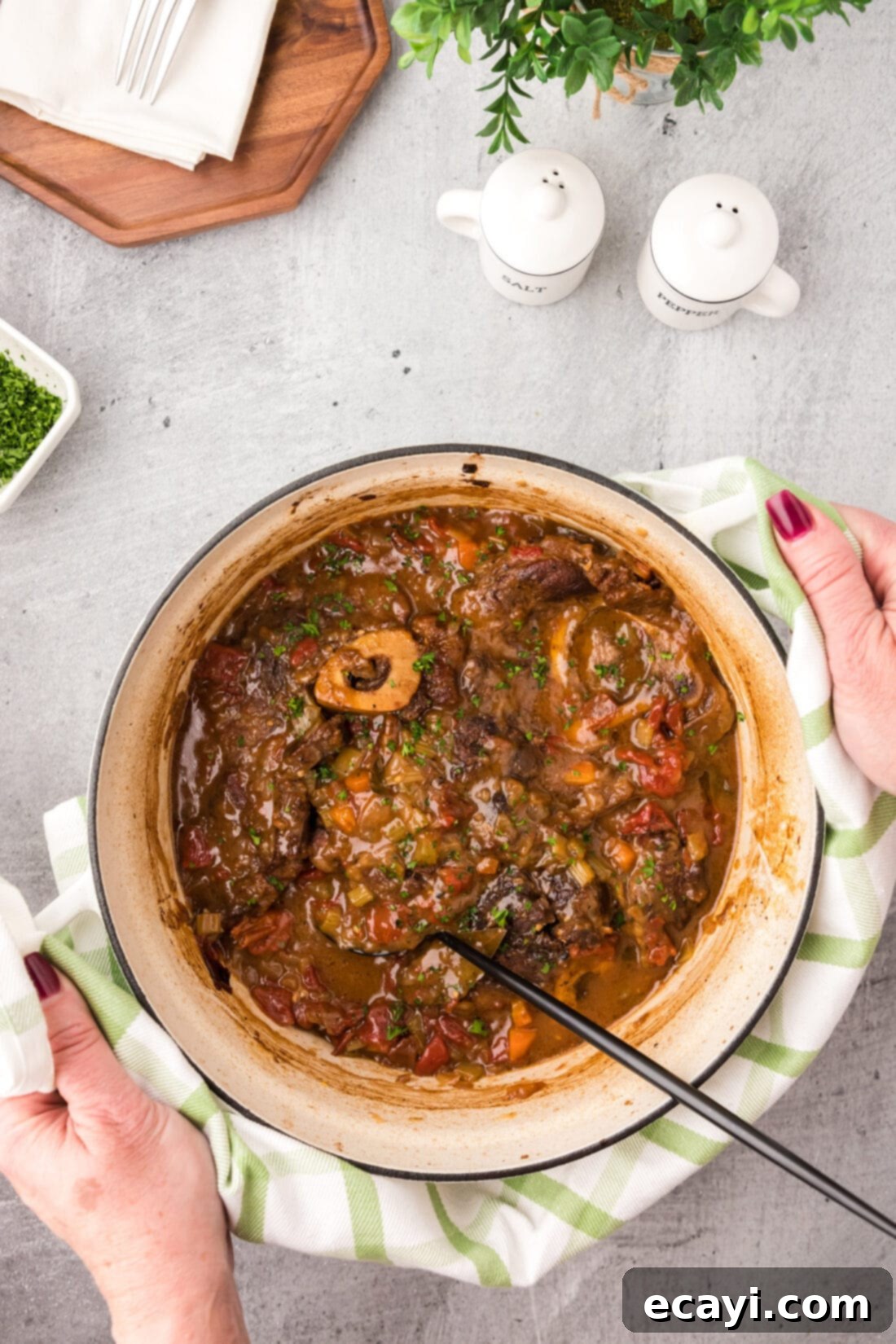
Key Ingredients for Braised Beef Shanks
To create this magnificent dish, you’ll need a selection of fresh, high-quality ingredients. All precise measurements and detailed instructions can be found in the printable recipe card at the very end of this comprehensive guide. Here’s a breakdown of the essential components:
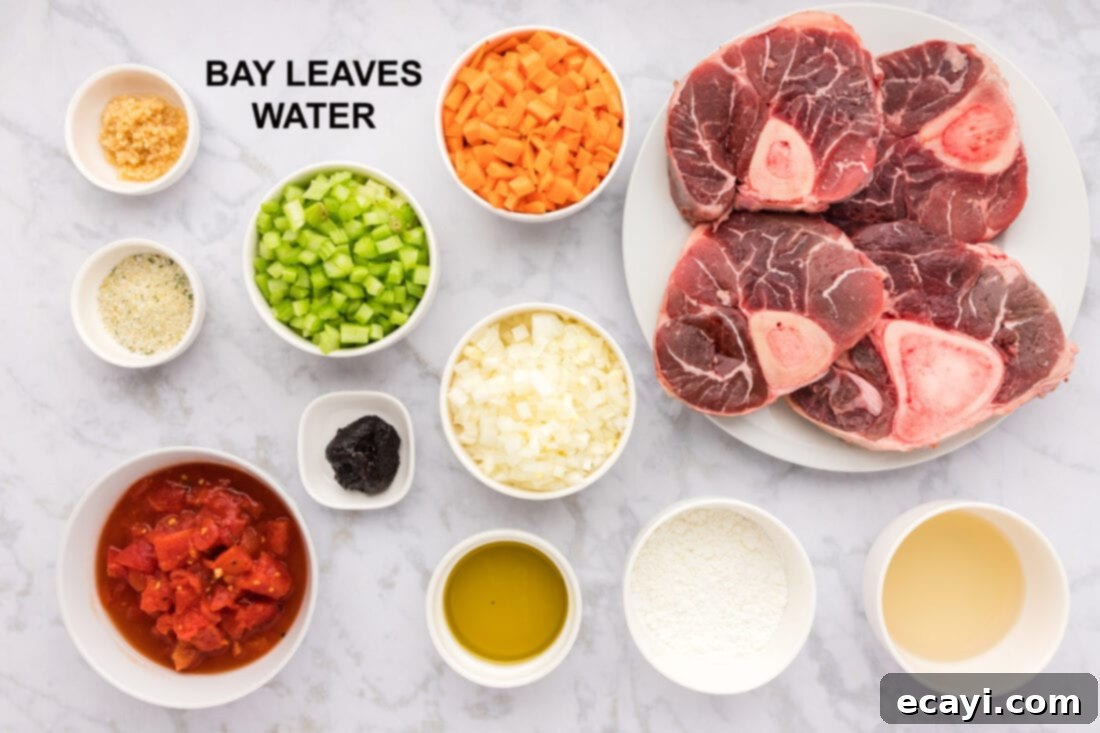
Ingredient Spotlight & Expert Substitution Advice
- Beef Shanks: These are the star of our show. Beef shanks are cross-cut sections of the leg, renowned for their rich flavor derived from the bone marrow and abundant connective tissue. While they may appear tough raw, this is precisely why they are ideal for slow braising. The long, gentle cooking process gradually breaks down the collagen, transforming it into gelatin, which yields incredibly tender meat and a luscious, thickened sauce. When selecting beef shanks, look for pieces with good marbling and a visible bone with marrow in the center for maximum flavor.
- Garlic Salt: A convenient blend that adds both savory garlic notes and necessary seasoning to the beef. You can certainly use individual garlic powder and salt if you prefer, adjusting ratios to your taste. Start with a generous seasoning of salt and then add garlic powder, black pepper, and perhaps a touch of paprika for added depth.
- Cornstarch: Used for dusting the beef shanks before searing. This step helps create a beautiful brown crust and also aids in thickening the braising liquid later on, giving it a smooth, velvety consistency. If you prefer a gluten-free option, arrowroot powder can be used as a substitute, but add it closer to the end of cooking as it can break down with prolonged heat.
- Olive Oil: Essential for searing the beef shanks and sautéing the vegetables. Use a good quality extra virgin olive oil for its flavor, or a lighter olive oil for higher smoke point if preferred.
- Dry White Wine: This is key for deglazing the pan and adding a layer of sophisticated flavor. A dry white wine such as Pinot Grigio, Sauvignon Blanc, or an unoaked Chardonnay works wonderfully. The alcohol evaporates during cooking, leaving behind a complex flavor. If you prefer not to use wine, a good quality beef broth or stock can be substituted, though the flavor profile will be slightly different.
- Minced Garlic, Chopped Onion, Carrots, and Celery (Mirepoix): These foundational aromatics are indispensable in French and Italian cooking. They provide a sweet, savory, and earthy base flavor that permeates the entire dish. Freshly minced garlic is always recommended for the best aroma. Ensure vegetables are chopped into roughly uniform pieces to cook evenly.
- Jarred Beef Base: This concentrate adds an intense beefy flavor to the braising liquid, enhancing the overall richness. Brands like Better Than Bouillon are excellent choices. If you don’t have beef base, you can use beef bouillon cubes or, ideally, a high-quality beef stock or broth. Adjust the amount of water accordingly if using liquid stock instead of base.
- Canned Diced Tomatoes (do not drain): Tomatoes bring a touch of acidity and sweetness, brightening the flavor of the rich meat and creating a balanced sauce. Diced tomatoes are convenient, but crushed tomatoes could also be used for a smoother sauce. The liquid from the can contributes to the braising liquid.
- Water: Used to adjust the liquid level for braising, ensuring the shanks are mostly submerged. If you’re using beef stock instead of beef base, you might use less water or even omit it, depending on the volume of stock.
- Bay Leaves: These aromatic leaves infuse a subtle, herbaceous note into the braising liquid, adding depth and complexity to the overall flavor. Remember to remove them before serving.
How to Master Braised Beef Shanks: Step-by-Step Guide
These step-by-step photos and detailed instructions are here to help you visualize how to make this exquisite recipe. For a convenient printable version, complete with precise measurements and instructions, simply Jump to Recipe at the bottom of this post.
- First, preheat your oven to 325 F (160 C). This lower temperature is essential for the slow, gentle cooking process that yields tender beef.
- Generously season both sides of your beef shanks with garlic salt. Don’t be shy – this initial seasoning forms a crucial flavor layer. Ensure an even coating for maximum taste.

- Place about half a cup of cornstarch in a shallow dish or on a plate. Press both sides of each seasoned beef shank firmly into the cornstarch, ensuring they are well coated. Set the remaining cornstarch aside, as you will use it later to help thicken the sauce.

- Heat 4 tablespoons of olive oil in a large Dutch oven over medium-high heat until it’s shimmering. Carefully place the cornstarch-coated shanks into the hot oil. You will likely need to work in batches to avoid overcrowding the pan, which would steam the meat instead of searing it. Cook each side for about 3 minutes, or until a deep golden-brown crust forms. Remove the seared shanks and set them aside on a plate or baking pan, then repeat with any remaining shanks. This searing step is crucial for developing rich flavor.



- With the shanks removed, the pan will have browned bits (fond) stuck to the bottom. Deglaze the pan by pouring in the ¼ cup of dry white wine. Scrape the bottom of the pan with a wooden spoon or spatula, stirring constantly, to lift all those flavorful bits. This step adds incredible depth to your sauce.

- Once the wine begins to boil and reduce slightly, add the minced garlic, chopped onion, chopped carrots, and chopped celery to the pan. Stir these vegetables into the liquid and cook for 4-5 minutes, or until they begin to soften and become tender, stirring occasionally.


- Season the vegetables to taste with additional garlic salt.

- Sprinkle the remaining cornstarch over the softened vegetables. Add the jarred beef base and stir everything together thoroughly until well combined. The cornstarch will help thicken the sauce beautifully during braising.


- Stir in the canned diced tomatoes (do not drain, as the liquid is essential) and ¾ cup of water. Return the seared beef shanks to the pan, nestling them gently into the vegetable and liquid mixture so that they are mostly submerged.


- Add the bay leaves to the pot. Place the lid securely on the Dutch oven and transfer it to your preheated oven. Bake for a minimum of 3 hours. The shanks should be incredibly tender, easily falling apart when pierced with a fork.

Frequently Asked Questions & Expert Tips for Perfect Braised Beef Shanks
Once cooled to room temperature, transfer any leftover braised beef shanks and their luscious sauce into an airtight container. They will keep beautifully in the refrigerator for 3-4 days. The flavors often deepen and improve overnight, making leftovers even more delicious!
Absolutely! Beef shanks are a fantastic alternative to veal for Osso Buco. If you’re keen on using veal, we highly recommend checking out our dedicated veal osso buco recipe. It utilizes many of the same ingredients but typically requires a slightly shorter cooking time due to veal’s more delicate texture.
A dry white wine is ideal for braising beef shanks. Varietals like Pinot Grigio, Sauvignon Blanc, or an unoaked Chardonnay work perfectly. Avoid sweet wines, as they can alter the savory balance of the dish. Remember, use a wine you would enjoy drinking!
Yes, this recipe is adaptable! For a slow cooker, follow the searing and deglazing steps on the stovetop, then transfer everything to your slow cooker. Cook on low for 6-8 hours or on high for 3-4 hours, until the beef is fork-tender. For an Instant Pot, use the “Saute” function for searing and deglazing, then pressure cook on high for 45-60 minutes, followed by a natural pressure release. Always check for tenderness and adjust cooking times as needed.
If your sauce isn’t as thick as you’d like after braising, you can remove the beef shanks, bring the sauce to a simmer on the stovetop, and reduce it further. Alternatively, create a slurry with 1-2 tablespoons of cornstarch mixed with an equal amount of cold water, then whisk it into the simmering sauce until thickened. If the sauce is too thick, simply add a splash of beef broth or water until it reaches your desired consistency.
The initial searing of the beef shanks is perhaps the most important step for flavor development. Ensure your pan is hot and don’t overcrowd the shanks. Give them ample time to develop a deep, rich brown crust on all sides. This golden-brown exterior contributes significantly to the savory depth of your final sauce.
Once the beef shanks are done braising, allowing them to rest in the hot sauce for 10-15 minutes after removing from the oven, with the lid on, allows the juices to redistribute. This results in even more tender and flavorful meat.
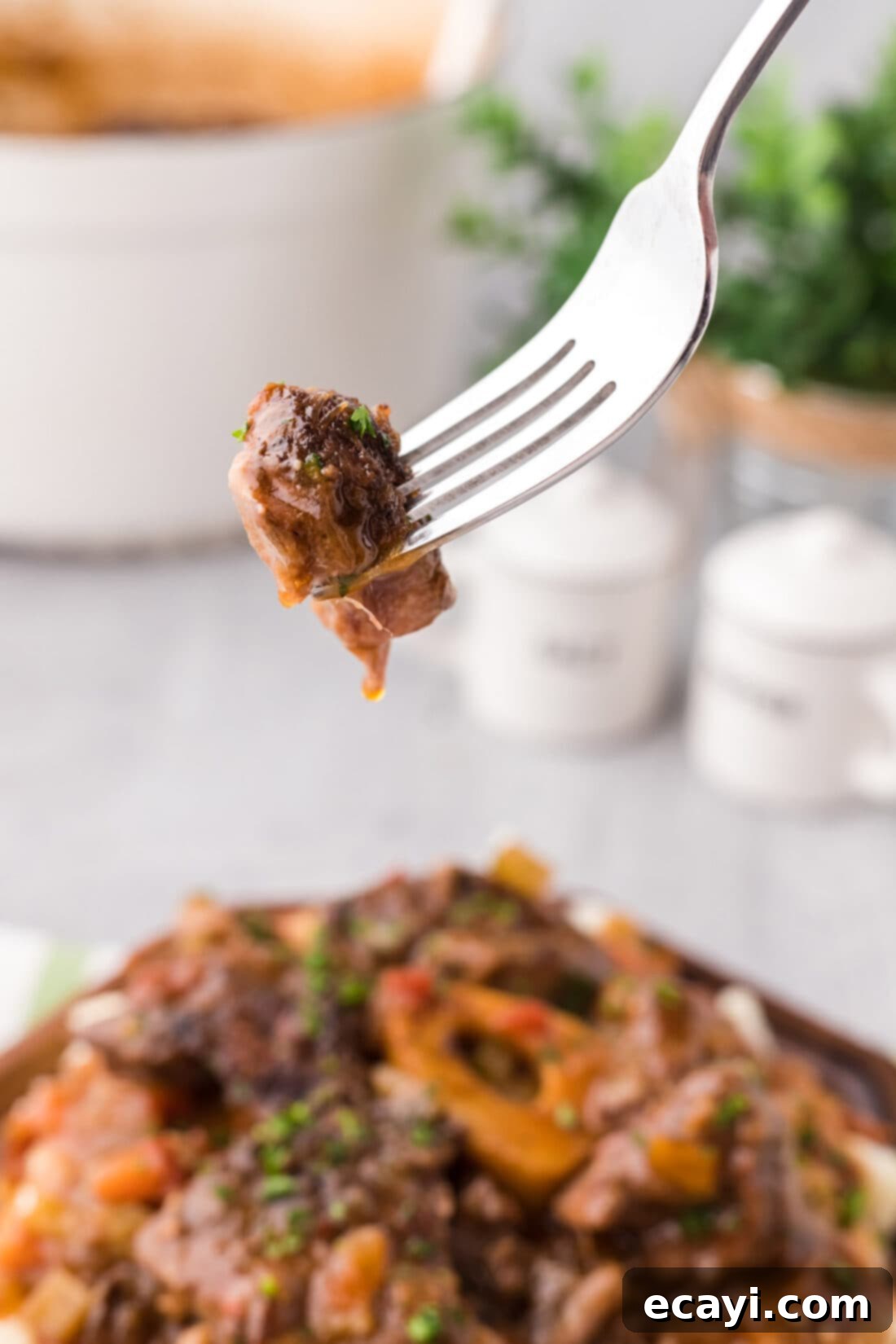
Delectable Serving Suggestions
Braised beef shanks are a versatile dish that pairs beautifully with a variety of sides. Traditionally, much like Osso Buco, they are served over creamy polenta or a rich risotto, allowing the grains to soak up every drop of the exquisite braising liquid. However, you can also serve them over fluffy mashed potatoes, steamed rice, or even a hearty egg noodle for a equally comforting meal. Don’t forget to generously spoon that savory, thickened braising liquid over your chosen accompaniment – it’s packed with flavor and is integral to the complete experience. A sprinkle of fresh parsley or a vibrant gremolata (a zest of lemon, minced garlic, and fresh parsley) adds a burst of freshness that wonderfully cuts through the richness of the dish.
Discover More Irresistible Beef Recipes
If you love hearty beef dishes, be sure to explore these other fantastic recipes that offer similar comfort and flavor:
- Classic Braised Beef
- Flavorful Beef Bulgogi
- Elegant Beef Bourguignon
- Comforting Beef Tips and Gravy
- Hearty Beef Stew Biscuit Pot Pie
- Rich Braised Oxtail
I absolutely adore sharing my passion for baking and cooking with all of you! To make sure you never miss a delicious new recipe, I offer a convenient newsletter delivered directly to your inbox every time a new post goes live. Simply subscribe today and start receiving your free daily recipes, bringing culinary inspiration right to your kitchen!
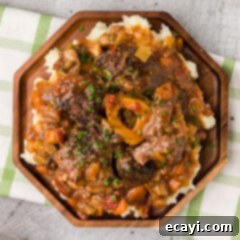
Braised Beef Shanks
IMPORTANT – There are often Frequently Asked Questions within the blog post that you may find helpful. Simply scroll back up to read them!
Print It
Pin It
Rate It
Save It
Saved!
Ingredients
- 2 ½ pounds beef shanks about 4 shanks, with bone in
- garlic salt to taste, or separate garlic powder & salt
- ½ cup cornstarch divided for dredging and thickening
- 4 Tablespoons olive oil
- ¼ cup dry white wine e.g., Pinot Grigio, Sauvignon Blanc
- 1 Tablespoon minced garlic freshly minced is best
- 1 cup chopped onion yellow or white onion
- 1 cup chopped carrots
- 1 cup chopped celery
- 1 Tablespoon jarred beef base e.g., Better Than Bouillon, or 2 cups beef broth/stock
- 14 ounces canned diced tomatoes do not drain, juice included
- ¾ cup water adjust if using liquid stock instead of base
- 4 bay leaves remove before serving
Essential Equipment
-
Dutch oven oven safe, 5-6 quarts or larger is ideal
-
Tongs for easy handling of shanks
-
Wooden spoon or spatula for deglazing and stirring
Before You Begin & Recipe Notes
- As highlighted in our serving suggestions, braised beef shanks are traditionally served over creamy polenta or a rich risotto, but they are equally delicious over fluffy mashed potatoes or rice. Don’t forget to spoon plenty of the savory braising liquid over your dish!
- The ultimate sign of perfectly braised beef shanks is their incredible tenderness; the meat should literally be fall-off-the-bone. Using a large slotted spoon or a sturdy spatula is the easiest way to gently remove the cooked meat from the pan without it falling apart.
- For optimal flavor and safety, ensure any cooled leftovers are stored promptly in an airtight container in the refrigerator. They will remain fresh and delicious for 3-4 days.
- For an even richer flavor, consider adding a sprig of fresh rosemary or thyme along with the bay leaves during the braising process.
- Always taste and adjust seasoning (salt, pepper, herbs) before serving to ensure the flavors are perfectly balanced.
Instructions
-
Preheat your oven to 325 F (160 C).
-
Generously season both sides of the beef shanks with garlic salt, ensuring an even coat.
-
Place ½ cup of cornstarch in a shallow dish. Press both sides of the seasoned shanks into the cornstarch, coating them evenly. Reserve any remaining cornstarch.
-
Heat 4 Tablespoons of olive oil in a Dutch oven over medium-high heat until shimmering. In batches if necessary (to avoid overcrowding), sear the prepared shanks for about 3 minutes per side, until deeply browned. Remove seared shanks and set aside.
-
Deglaze the pan by adding ¼ cup dry white wine, stirring and scraping up any browned bits from the bottom of the Dutch oven.
-
Once the wine begins to boil, add the minced garlic, chopped onion, chopped carrots, and chopped celery. Stir and cook for 4-5 minutes, until vegetables begin to soften.
-
Season the cooked vegetables to taste with additional garlic salt.
-
Sprinkle the remaining cornstarch over the vegetables. Add 1 Tablespoon of jarred beef base and stir well to combine, ensuring no lumps.
-
Stir in the 14 ounces of canned diced tomatoes (undrained) and ¾ cup of water. Return the seared beef shanks to the pan, nestling them so they are mostly submerged in the liquid.
-
Add the 4 bay leaves to the pot. Place the lid on the Dutch oven and bake in the preheated oven for 3 hours, or until the beef shanks are incredibly tender and fall off the bone.
Nutrition Information
The recipes on this blog are tested with a conventional gas oven and gas stovetop. It’s important to note that some ovens, especially as they age, can cook and bake inconsistently. Using an inexpensive oven thermometer can assure you that your oven is truly heating to the proper temperature. If you use a toaster oven or countertop oven, please keep in mind that they may not distribute heat the same as a conventional full sized oven and you may need to adjust your cooking/baking times. In the case of recipes made with a pressure cooker, air fryer, slow cooker, or other appliance, a link to the appliances we use is listed within each respective recipe. For baking recipes where measurements are given by weight, please note that results may not be the same if cups are used instead, and we can’t guarantee success with that method.
